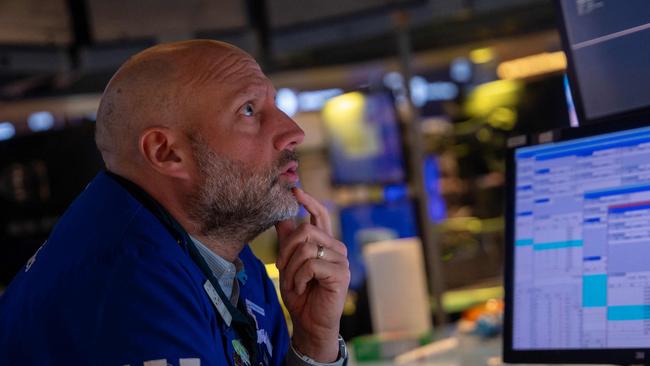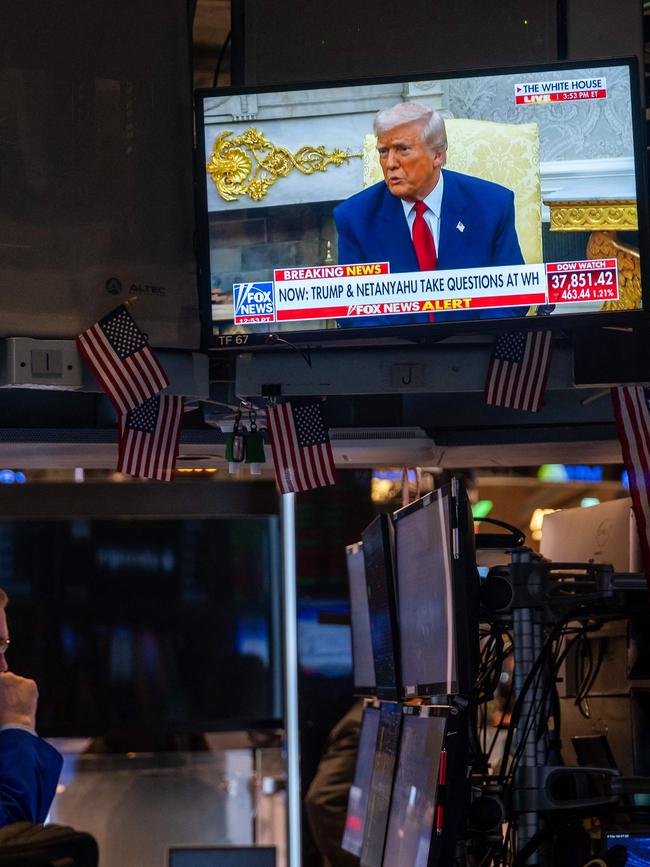Global stocks rebound sharply in volatile trading, putting meltdown on hold after trillions of losses
The Australian dollar and industrial commodities recovered as investors paused to catch-up on the global equities fire sale.

Stocks rebounded sharply in a twist on the volatile trading that has vexed global markets since US president Donald Trump slammed tariffs on the world’s exporters.
The Australian dollar and commodities including copper and crude oil also recovered as investors judged they were oversold after three days of chaos and trillions of dollars of losses.
In its best day since November 2022, the ASX 200 rose 166.7 points, or 2.3 per cent, to 7510, clawing back over half of a $112bn wipeout on Monday, its worst in five years.
CBA rose 2.8 per cent, BHP gained 2.3 per cent and Macquarie Group closed up 3.8 per cent.
After plunging to 4.2 per cent on Monday, Australia’s S&P/ASX 200 benchmark had fallen 14.2 per cent from a record high closing level of 8555.8 points seven weeks ago, halfway to a bear market amid a global rout sparked by the trade war.
However, after the 6 per cent crash in the S&P 500 on Friday, and a massive intraday rebound of 8.5 per cent on Monday after an erroneous headline suggested Trump was about to put US tariffs on hold for three months, investors simply couldn’t help but buy the dip.
After falling as much as 1.5 per cent to a five-year low of US59.33c on Monday, the Australian dollar shot up 1.1 per cent to US60.52 amid a slight fall in the US dollar and strong gains in commodity prices.
US copper futures rose 3.1 per cent to $US4.31 per pound after dropping 4.9 per cent on Monday.
Brent crude oil futures rose 0.8 per cent to $US64.74 per barrel after hitting $US65.21.
Safe-haven gold was back on the rise, up 0.8 per cent to $US3006.80 per ounce.
Analysts warned markets remain vulnerable after the plunge, caused by a trade war which showed no sign of abating. The VIX volatility index hit an eight-month high of 60 per cent on Monday before falling back to a still-elevated 47 per cent as US stocks recovered.
“Given the speed of the market collapse, the widespread panic and the unwind in equity positioning, in the short term, odds for a tactical squeeze are high, especially if there are any positive headlines,” JP Morgan’s head of global market strategy Dubravko Lakos-Bujas said.

But, with JPMorgan now assuming a US recession this year if the announced tariffs remain in place, he said the outlook for stocks remains “highly dependent on trade policy direction”.
“Due to the highly unique backdrop — the fate of the equity market is essentially in the hands of one individual who can unilaterally ease or deepen this shock — the range of outcomes for risk assets globally is abnormally wide and binary,” he added.
“Even though we do not believe US exceptionalism is over, this shock came at a time when valuation was rich, positioning was crowded and leadership was particularly narrow. More so, the lack of the Trump put and disregard for stocks has further fuelled the relentless selling.”
The Trump ‘put’ refers to the propensity of Trump to change course in response to falling stock prices.
And consensus earnings estimates were “stale and mostly policy agnostic,” according to Mr Lakos-Bujas.
“Given the complexity of global trade, further complicated by inventory restocking by both buyers and sellers in recent months, the real effect of tariffs may not be known for months.”
Driven by a 27 per cent fall in the Magnificent 7 index of US tech giants since December, the 12-month forward price-to-earnings multiple of the S&P 500 has fallen from about 23 times to about 18.3 times. However, the consensus forecast for earnings per share has barely fallen.
The rebound in most risk assets came despite a new threat by Trump to put an extra 50 per cent tariff on China if it retaliates against his 34 per cent “reciprocal” tariff with its own 34 per cent tariff.
The US tariff hike is due to start on Wednesday. China’s tariff hike is due on Thursday.
Singapore iron ore futures fell 2.6 per cent to a three-month low of $US95 per tonne as China vowed to “fight till the end” on tariffs, rather than launch any major new fiscal stimulus to counter the domestic economic impact of the trade war.
In the first Chinese government response to the American president’s latest attack, China’s Commerce Ministry said the country would “never accept” such “blackmail” from America.
“The US threat to escalate tariffs on China is a mistake that only adds to its (earlier) mistake, once again exposing the essence of US blackmail. China will never accept this,” the Chinese Commerce ministry said in a statement. “If the US insists on its own way, China will fight till the end.”
The rebound in shares came amid a correspondingly massive selloff in safe-haven US Treasury bonds. The 10-year yield closed up 19 basis points at 4.18 per cent on Monday after hitting a six-month low of 4.87 per cent. Yield moves inversely to price.
But, Citi global rates trading strategist Ben Wiltshire warned the violent rebound in US Treasuries may signal a “regime shift”, rather than an improved risk appetite.
“The US bond market sell-off may appear to be an increase in risk appetite,” he said.
“However, the simultaneous high-yield US credit spread widening suggests otherwise.
“The US Treasury selloff may be signalling a regime shift, whereby US Treasuries are no longer the global fixed income safe haven in periods of risk-off.”
Wiltshire said investors may shift to alternative G10 sovereign bonds — such as those of Europe and Australia — amid a renewed focus on the outlook for the US budget deficit and bond supply. US budget reconciliation developments this week are set to be a key focus.
Meanwhile, funding markets were also coming into focus globally.
“Simply put, there are a lot of bonds and a lot of leverage,” Wiltshire added. “Add volatility to the mix and funding has a renewed focus.”






To join the conversation, please log in. Don't have an account? Register
Join the conversation, you are commenting as Logout